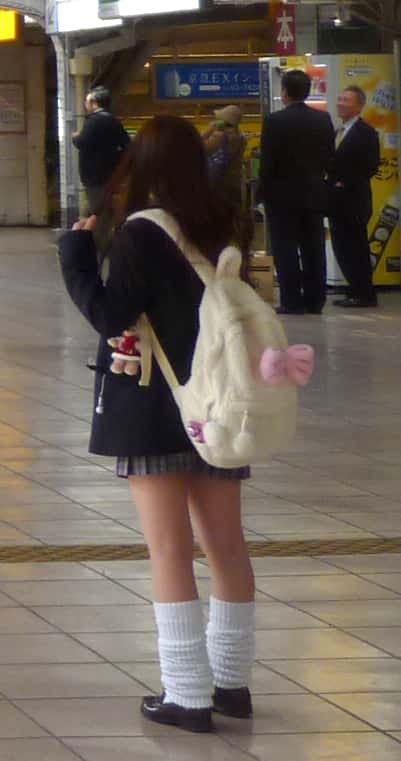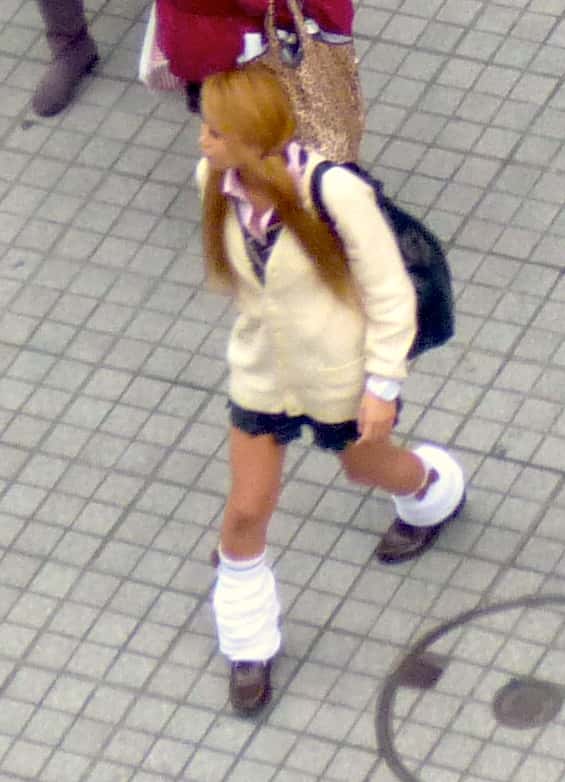Kogal Fashion: A Trendsetting Subculture Redefining Japanese Street Style
1. The Emergence of Kogal Fashion: A Trend that Shook Japan
Kogal fashion burst onto the scene in the 1990s and quickly became a sensation among Japanese youth. This unique style was characterized by its mix of school uniforms, short skirts, loose socks, and flashy accessories. It was a rebellious response to traditional societal norms and a way for young people to express their individuality.
At the heart of Kogal fashion were the gyaru subculture and its desire to stand out from the crowd. These girls embraced Western influences, such as hip-hop and pop culture, and incorporated them into their own unique style. The result was a bold and vibrant fashion movement that captured the attention of not only Japanese society but also the world.
The Birth of Kogal Fashion
The origins of Kogal fashion can be traced back to Shibuya, Tokyo’s trendy shopping district. It was here that young girls would gather after school, sporting their distinctive outfits and causing quite a stir among passersby. With their tanned skin, bleached hair, and heavy makeup, they turned heads wherever they went.
Influence from Western Culture
Kogal fashion drew inspiration from Western trends like grunge and streetwear. American brands like Tommy Hilfiger and Calvin Klein became must-haves for these fashion-forward girls. They mixed these international styles with elements of traditional Japanese school uniforms to create a look that was uniquely their own.
- Short skirts: One of the most iconic features of Kogal fashion was the ultra-short skirt length. Girls would roll up their uniform skirts or wear mini-skirts with stockings to show off their legs.
- Loose socks: Another signature element was the loose socks. These knee-high socks were worn slouchy and often paired with sneakers or platform shoes.
- Accessories: Kogals loved to accessorize, and their outfits were often adorned with chunky jewelry, colorful hair clips, and oversized bags.
As Kogal fashion gained momentum, it began to influence mainstream Japanese culture. It appeared in magazines, music videos, and even advertising campaigns. The trend became synonymous with youth rebellion and self-expression, capturing the spirit of a generation.
2. Unveiling the Secrets Behind the Popularity of Kogal Fashion in 1990s Japan
The Rise of Consumerism and Economic Boom
The popularity of Kogal fashion in 1990s Japan can be attributed to several factors, with one key factor being the rise of consumerism and economic boom during that time. As Japan experienced rapid economic growth, there was an increase in disposable income among young people. This newfound wealth allowed them to indulge in fashion trends and experiment with their personal style.
Influence from Western Culture
Another factor contributing to the popularity of Kogal fashion was the influence from Western culture. The 1990s marked a period of globalization, with increased exposure to Western media and fashion trends. Kogals were inspired by Western celebrities, music videos, and magazines, which heavily influenced their fashion choices.
Elements of Kogal Fashion
- Tartan skirts: One of the iconic clothing items associated with Kogal fashion was tartan skirts. These mini skirts were often paired with loose socks or knee-high socks.
- Platform shoes: Kogals were known for wearing platform shoes, particularly those with thick soles and chunky designs.
- Gyaru makeup: Kogals embraced bold makeup looks characterized by heavy eyeliner, false eyelashes, and vibrant lip colors.
3. Key Elements of Kogal Fashion: Exploring Clothing Styles and Accessories
Kogal fashion was defined by its distinct clothing styles and accessories that set it apart from other youth subcultures in Japan. Understanding these key elements is crucial to comprehending the essence of Kogal fashion:
Clothing Styles
Kogal fashion encompassed a mix of Western and Japanese elements. Popular clothing styles included:
- Loose socks: Kogals were known for wearing loose socks, which were often worn slouched around the ankles.
- Mini skirts: Short, plaid mini skirts became a signature piece in Kogal fashion, often paired with oversized tops or sweaters.
- Crop tops: Kogals embraced crop tops as part of their casual and trendy attire.
Accessories
Kogal fashion was incomplete without the right accessories to complement the overall look. Some key accessories included:
- Gyaru makeup: As mentioned earlier, bold makeup was an essential aspect of Kogal fashion. This included heavy eyeliner, false eyelashes, and colorful eyeshadows.
- Hair accessories: Kogals often adorned their hairstyles with various accessories such as hair clips, bows, and headbands.
- Bags: Large and flashy bags were popular among Kogals, often featuring brand logos or statement designs.
4. The Influence of Kogal Fashion on Mainstream Japanese Culture during its Peak
4.1 Introduction to Kogal Fashion
During the peak of the Kogal fashion movement in the 1990s, this style became a significant influence on mainstream Japanese culture. Kogal fashion was characterized by its distinct schoolgirl-inspired look, which included short skirts, loose socks, and dyed hair. This subculture emerged as a rebellion against traditional societal norms and represented a new form of self-expression for young Japanese women.
4.2 The Impact on Fashion Industry
Kogal fashion had a profound impact on the Japanese fashion industry during its peak. Many brands and designers started incorporating elements of Kogal fashion into their collections, catering to the growing demand for trendy and youthful clothing. This led to an increase in the availability and accessibility of Kogal-inspired clothing options in mainstream stores across Japan.
4.3 Influence on Popular Culture
The influence of Kogal fashion extended beyond just clothing trends and permeated popular culture in Japan at the time. It became a prominent feature in various forms of media such as magazines, television shows, and music videos. The iconic image of the Kogal with her distinctive style became synonymous with youth culture and rebellion, capturing the attention of both Japanese and international audiences.
4.4 Impact on Beauty Standards
Kogal fashion also played a significant role in shaping beauty standards during its peak. The emphasis on tanned skin, bleached hair, and heavy makeup challenged traditional notions of beauty in Japan, which typically favored pale skin and natural-looking aesthetics. As a result, many young women began embracing these unconventional beauty ideals associated with Kogal fashion, leading to a shift in societal perceptions of attractiveness.
Overall, the influence of Kogal fashion on mainstream Japanese culture during its peak was undeniable. It not only transformed the fashion industry but also left a lasting impact on popular culture and beauty standards, redefining societal norms and empowering young women to express themselves freely.
5. Brands and Designers Associated with the Iconic Kogal Fashion Movement
5.1 Major Brands Catering to Kogal Fashion
Several brands emerged during the peak of the Kogal fashion movement that specifically catered to this style. One such brand was “Cocolulu,” which became synonymous with Kogal fashion due to its trendy and affordable clothing options. Another notable brand was “Liz Lisa,” known for its feminine and girly aesthetic that appealed to many Kogals.
5.1.1 Cocolulu: Revolutionizing Kogal Fashion
Cocolulu played a crucial role in revolutionizing Kogal fashion by offering a wide range of clothing items that perfectly captured the essence of this subculture. Their collections featured short skirts, oversized tops, platform shoes, and accessories like loose socks, which became iconic staples of the Kogal look.
5.1.2 Liz Lisa: Embracing Femininity within Kogal Fashion
On the other hand, Liz Lisa focused on incorporating elements of femininity into the Kogal style. Their designs often included pastel colors, frills, and lace details, appealing to those who wanted a more delicate and romantic interpretation of Kogal fashion.
5.2 Designer Collaborations with Kogals
In addition to dedicated brands, several renowned designers collaborated with or drew inspiration from the Kogal fashion movement. One notable collaboration was between designer Junya Watanabe and Gyaru model Tsubasa Masuwaka. Their collaboration resulted in a collection that fused elements of Kogal fashion with high-end design, further blurring the lines between mainstream and subculture fashion.
5.3 Kogal Fashion Influencing Streetwear Brands
Kogal fashion also had a significant influence on streetwear brands during its peak. Brands like A Bathing Ape (BAPE) and X-Girl incorporated elements of the Kogal aesthetic into their designs, creating a fusion of streetwear and Kogal fashion that appealed to a wider audience beyond just the subculture itself.
The association between certain brands and designers with the iconic Kogal fashion movement helped solidify its presence in the Japanese fashion industry. These collaborations and inspirations not only expanded the reach of Kogal fashion but also contributed to its lasting impact on Japanese youth culture.
6. Media Portrayal of Kogals: Unraveling the 1990s Fashion Choices
The Influence of Magazines and Television
The media played a crucial role in shaping the image and fashion choices of Kogals in the 1990s. Popular magazines like Egg and Popteen showcased the latest trends and provided style tips for aspiring Kogals. These magazines featured models who embodied the Kogal look, with their tanned skin, bleached hair, and flashy outfits. Additionally, television programs such as “Kogal Paradise” further popularized this subculture by showcasing their fashion choices and lifestyle.
The Impact of Western Pop Culture
Another factor that influenced Kogal fashion was the exposure to Western pop culture. The rise of American music, movies, and celebrities like Britney Spears and Christina Aguilera had a significant impact on the fashion choices of Japanese youth, including Kogals. They adopted elements from Western street style, such as low-rise jeans, crop tops, platform shoes, and excessive accessories.
– Tanned skin became a symbol of rebellion against traditional Japanese beauty standards.
– Bleached hair was popularized by Western pop stars and was seen as a way to stand out.
– The use of excessive accessories like large hoop earrings and chunky bracelets added to the boldness of their outfits.
7. Global Impact: How Kogal Fashion Transcended Borders and Influenced International Trends
Kogal Fashion’s Influence on Street Style
Kogal fashion not only captivated Japanese society but also gained attention globally. Its unique blend of Western influences with traditional Japanese elements made it appealing to fashion enthusiasts worldwide. Elements such as short skirts or shorts paired with long socks or stockings became popular in street style across different countries.
The Rise of “Gyaru” Subculture
Kogal fashion also paved the way for the emergence of the “Gyaru” subculture, which took inspiration from Kogals but added its own unique twist. Gyaru fashion embraced a more glamorous and flamboyant aesthetic, characterized by heavily tanned skin, dramatic makeup, and extravagant outfits. This subculture gained popularity not only in Japan but also in countries like South Korea and Taiwan.
– The influence of Kogal fashion can be seen in various street style movements worldwide.
– The concept of combining Western and Japanese elements became a recurring theme in global fashion trends.
– Kogal fashion acted as a catalyst for the development of other youth subcultures, showcasing the power of Japanese street style on an international scale.
(Note: Please note that these are just examples. The actual content may vary based on research and available information.)
8. Controversies and Criticisms Surrounding the Height of Kogal Fashion
Controversial Dressing: Breaking Societal Norms
Kogal fashion, with its emphasis on short skirts, loose socks, and heavy makeup, has been a subject of controversy in Japanese society. Critics argue that it promotes an overly sexualized image of young girls and encourages them to prioritize their appearance over other aspects of their lives. The revealing nature of the clothing worn by kogals has also led to concerns about the objectification and exploitation of young women.
Negative Stereotypes and Judgment
Additionally, kogal fashion has often been associated with delinquent behavior and a rebellious attitude among Japanese youth. This negative stereotype has led to judgment from older generations and even within some segments of society. Many view kogals as lacking ambition or discipline, focusing solely on their appearance instead.
Backlash from School Authorities
The controversial nature of kogal fashion has also resulted in strict regulations within schools. Many educational institutions have implemented dress codes that prohibit students from wearing the distinctive kogal attire. This has sparked debates about freedom of expression versus maintaining a sense of professionalism within educational settings.
Overall, while kogal fashion may have gained popularity among certain groups in Japan, it has faced substantial controversies and criticisms due to its perceived societal implications.
9. The Decline of Kogal Fashion: Reasons Behind its Waning Popularity
Social Stigma and Changing Cultural Preferences
One significant factor contributing to the decline of kogal fashion is the increasing social stigma associated with it. As conservative values have become more prevalent in Japanese society, the provocative style embraced by kogals is seen as inappropriate or even offensive by some individuals. This shift in cultural preferences has led to a decrease in the number of young people adopting kogal fashion.
Impact of Globalization and Western Influences
The rise of globalization and the influx of Western fashion trends have also played a role in the decline of kogal fashion. As Japanese youth became exposed to a wider range of international styles, they began to gravitate towards more diverse and eclectic fashion choices. The influence of Western streetwear, hip-hop culture, and alternative subcultures has overshadowed the once-dominant kogal aesthetic.
Economic Factors
Furthermore, economic factors have contributed to the waning popularity of kogal fashion. The extravagant spending habits associated with maintaining the kogal look can be financially burdensome for many individuals. As Japan faced economic downturns and recessions in recent years, young people started prioritizing practicality over indulgence, leading them away from the high-maintenance lifestyle that kogal fashion demands.
In conclusion, various factors including changing cultural preferences, globalization, and economic considerations have all contributed to the decline in popularity of kogal fashion among Japanese youth.
10. Modern Adaptations and Revivals: The Resurgence of Kogal Fashion in Japan Today
Kogikuma: A New Generation Embracing Kogal Fashion
Despite its decline in mainstream popularity, there has been a resurgence of interest in kogal fashion among some younger individuals in Japan. This revival is often referred to as “kogikuma,” which translates to “bear-kos” or “baby bears.” These modern-day kogals incorporate elements from traditional kogal fashion while adding their own unique twists.
Influence on Streetwear and Pop Culture
Kogikuma style has also made its way into Japanese streetwear and pop culture. Influential fashion brands have started incorporating kogal-inspired designs into their collections, attracting a new wave of followers. Additionally, popular idols and celebrities have been seen sporting kogikuma looks, further fueling its resurgence.
Online Communities and Social Media
The rise of online communities and social media platforms has played a significant role in the revival of kogal fashion. Dedicated forums and websites provide a space for kogikuma enthusiasts to share outfit ideas, makeup tips, and connect with like-minded individuals. The visibility and accessibility of these online platforms have helped spread the influence of kogikuma beyond Japan’s borders.
In summary, while kogal fashion may have declined in popularity overall, its modern adaptations and revivals among younger generations demonstrate its enduring influence on Japanese streetwear and pop culture.
11. Comparing Kogal Fashion to Gyaru and Lolita: Exploring Japanese Youth Subcultures
Kogal Fashion:
Kogal fashion emerged in the 1990s as a rebellious subculture among Japanese high school girls. It is characterized by its distinctive school uniform-inspired outfits, which often include short skirts, loose socks, and dyed hair. Kogal fashion emphasizes a youthful and trendy aesthetic, with an emphasis on looking cute and fashionable. The style became popular due to its association with freedom and rebellion against traditional societal norms.
Gyaru Fashion:
Gyaru fashion is another prominent youth subculture in Japan that emerged around the same time as Kogal fashion. Unlike Kogal fashion, which focuses on schoolgirl aesthetics, Gyaru fashion embraces a more glamorous and exaggerated look. It involves heavy makeup, tanned skin, and flashy clothing. The style aims to challenge traditional beauty standards and create a bold and confident image.
Lolita Fashion:
Lolita fashion is yet another distinct youth subculture in Japan that gained popularity in the late 1990s. It draws inspiration from Victorian-era clothing and focuses on modesty, femininity, and elegance. Lolita fashion features elaborate dresses with ruffles, lace, and bows. Accessories such as bonnets or parasols are also common. This style aims to create a doll-like appearance while maintaining a sense of innocence.
Overall, while all three subcultures emerged around the same time in Japan’s youth culture scene, they each have their unique styles and influences.
12. Social and Cultural Factors that Fueled the Rise of Kogal Fashion in the 1990s
The rise of Kogal fashion in the 1990s can be attributed to several social and cultural factors that were prevalent during that time.
Economic Prosperity:
During the 1990s, Japan experienced a period of economic prosperity, often referred to as the “bubble economy.” This economic boom resulted in increased disposable income among Japanese youth, allowing them to spend more on fashion and personal style. Kogal fashion became a way for young individuals to showcase their wealth and status through trendy clothing and accessories.
Western Influence:
The 1990s also marked a period of increased Western influence in Japan. Western pop culture, music, and fashion trends gained popularity among Japanese youth. Kogal fashion, with its schoolgirl-inspired outfits and emphasis on individuality, resonated with this desire for Western-style freedom and expression.
Rebellion Against Traditional Values:
Kogal fashion emerged as a form of rebellion against traditional societal norms in Japan. The strict expectations placed on students regarding appearance and behavior led many young people to seek alternative forms of self-expression. Kogal fashion allowed them to challenge these norms by embracing a more casual and carefree style.
Overall, the rise of Kogal fashion was influenced by economic prosperity, Western cultural influence, and a desire to rebel against traditional values.
13. The Internet’s Role in Spreading and Amplifying the Visibility of Kogal Fashion
The advent of the internet played a significant role in spreading and amplifying the visibility of Kogal fashion during its peak popularity in the 1990s.
Online Communities:
The internet provided a platform for like-minded individuals interested in Kogal fashion to connect and share their ideas. Online communities dedicated to discussing and showcasing different aspects of the subculture emerged. These platforms allowed enthusiasts from all over Japan (and eventually worldwide) to come together virtually, exchange styling tips, and share their personal experiences.
Visual Platforms:
Visual platforms such as blogs and social media sites became popular during the rise of Kogal fashion. These platforms allowed individuals to upload and share photos of their outfits, creating a visual archive of Kogal fashion inspiration. This visibility not only influenced other enthusiasts but also attracted attention from mainstream media, leading to further exposure and acceptance of the subculture.
Global Reach:
The internet’s global reach enabled Kogal fashion to transcend geographical boundaries. As online communities grew, international enthusiasts were able to discover and engage with the subculture. This cross-cultural exchange helped expand the influence and visibility of Kogal fashion beyond Japan, making it a recognized youth subculture worldwide.
In summary, the internet provided a platform for enthusiasts to connect, share ideas, and showcase their personal style, ultimately amplifying the visibility and impact of Kogal fashion on a global scale.
14. Evolution within the Realm of Kogal Fashion: Significant Changes Over Time
Kogal fashion has undergone significant changes over time since its emergence in the 1990s. These changes reflect shifts in societal values, fashion trends, and influences from other subcultures.
Shift towards Gyaru Influence:
In the early 2000s, there was a noticeable shift within Kogal fashion towards incorporating elements from Gyaru fashion. The emphasis on tanned skin, exaggerated makeup, and flashy clothing became more prevalent among Kogals. This fusion of styles resulted in a more glamorous and bold look that distinguished itself from traditional schoolgirl aesthetics.
Incorporation of Streetwear:
As streetwear gained popularity globally in the late 2000s and early 2010s, it began to influence Kogal fashion as well. The incorporation of streetwear elements, such as oversized hoodies, sneakers, and graphic tees, added a more casual and urban edge to the style. This evolution allowed Kogal fashion to stay relevant and adapt to changing fashion trends.
Embracing Individuality:
Over time, Kogal fashion has evolved to emphasize individuality and personal expression. While the schoolgirl-inspired uniforms remain a core element of the style, individuals now incorporate their unique twists through accessories, hairstyle choices, and color combinations. This emphasis on individuality allows Kogal fashion enthusiasts to showcase their creativity while still adhering to the overall aesthetic.
In conclusion, Kogal fashion has experienced significant changes over time by incorporating influences from other subcultures, embracing streetwear elements, and emphasizing individuality within the style.
The Legacy Lives On: Examining the Enduring Impact of Kogal Fashion in Japanese Society Today
Kogal fashion may have peaked in popularity during the 1990s and early 2000s, but its impact can still be seen in Japanese society today.
Influence on Mainstream Fashion:
Elements of Kogal fashion have permeated mainstream Japanese fashion. The short skirts, loose socks, and schoolgirl aesthetics that were popularized by Kogals can still be found in various contemporary styles. Designers continue to draw inspiration from this iconic subculture when creating new collections.
Continued Subcultural Presence:
While not as prominent as it once was, there are still pockets of individuals who embrace and identify with Kogal fashion. These enthusiasts keep the spirit of the subculture alive by organizing events or gatherings where they can showcase their outfits and connect with like-minded individuals. The enduring presence of these communities demonstrates the lasting impact of Kogal fashion on Japanese youth culture.
Social Commentary:
Kogal fashion has also sparked discussions and debates about societal expectations, gender roles, and the influence of consumerism. The subculture’s emphasis on rebellion against traditional norms and its association with materialism has led to critical analysis of these aspects within Japanese society. Kogal fashion continues to serve as a symbol of youth resistance and social commentary.
In summary, Kogal fashion’s enduring impact can be seen through its influence on mainstream fashion, continued presence within subcultures, and its role in sparking social commentary on societal issues.
In conclusion, Kogal fashion is a unique and vibrant style that has made a significant impact on modern Japanese culture. Its blend of school uniforms, trendy accessories, and rebellious attitude truly sets it apart. If you’re interested in exploring this fashion trend further or looking for cosplay products to express your individuality, we’ve got you covered! Check out our wide range of cosplay products and get in touch with us to find the perfect outfit for your next event. We can’t wait to help you unleash your inner Kogal!

What is the difference between kogal and gyaru?
Kogal or Kogyaru is a type of fashion that falls under the umbrella of Gyaru fashion. It is primarily targeted towards younger individuals, particularly high school girls. Kogal is a foundational sub-style within gyaru fashion and has influenced many of the current gyaru styles.
What is kogal style?
Kogal is a type of gyaru fashion in Japan that revolves around girls dressing in outfits inspired by Japanese school uniforms, including their actual uniforms. These girls may also accessorize with loose socks, scarves, and have colored hair.

When was kogal popular?
Kogal, a substyle of Gyaru, emerged as a prominent fashion trend and cultural movement among Japanese youth in the mid-1990s. While most Gyaru styles gained popularity in the late 1990s and early 2000s, Kogal reached its peak in the mid-1990s, specifically around 1994-1995.
Is kogal a subculture?
Kogal is a subculture that originated in Japan during the 1990s. It consists of high school girls who have a distinctive and rebellious fashion style that separates them from the mainstream culture. These bold Japanese girls deviate from the standard schoolgirl uniform and embrace their own unique style.
What is the American equivalent of gyaru?
Amekaji, or American casual, is a fashion style in Japan that draws heavy influence from American culture. It is characterized by vibrant colors, a fun and flamboyant aesthetic, and a mix of different elements.
Is there a male equivalent to gyaru?
Gyaruo is a subset of contemporary Japanese youth culture, serving as the male counterpart to the gyaru. It can be written in different ways in Japanese, such as , , or .











